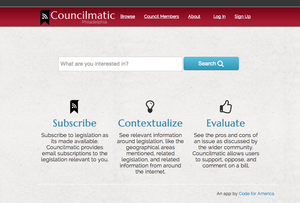Opportunities for strengthening open meetings with open data

Governments aren’t alone in thinking about how open data can help improve the open meetings process. There are an increasing number of tools governments can use to help bolster open meetings with open data. From making public records generated by meetings more easily accessible and reusable online to inviting the public to participate in the decision-making process from wherever they may be, these tools allow governments to upgrade open meetings for the opportunities and demands of the 21st Century.
Improving open meetings with open data may involve taking advantage of simple solutions already freely available online, developing new tools within government, using open-source tools, or investing in new software, but it can all help serve the same goal: bringing more information online where it’s easily accessible to the public.
Improving how information is shared
At the most basic level, governments should be providing information from open meetings online, where the public is already looking for it. For governments that already have websites, this can be done without substantial extra costs or needing to invest in any new software. It can be as simple as designating staff time and resources for posting the agendas, minutes, votes, and other relevant documents from meetings online. These documents should be in machine-readable format so anyone can search the text with a computer, and the documents should be in a central location to make them easily findable.

http://www.councilmatic.org/
There are many tools available for governments looking to invest in sharing information from open meetings as more than a collection of documents posted online. Sharing information as machine-processable (or structured) data, feeding it into an API, or allowing for bulk download opens a variety of opportunities for reuse of the information. Councilmatic, for example, is an open-source tool already being used in Philadelphia and Chicago to make legislative information from open meetings more usable to the public. Anyone using the website can search through and subscribe to email updates about specific city council legislation. The website also provides information about who sponsored bills and the latest actions that have been taken. These kinds of functions and more are available from a variety of other providers, too. Browsing the websites of local governments across the country shows nearly endless ways of providing information about open meetings. There are clearly many different approaches that can be taken to fit the technical skills, staff time, and budget each government has available. What matters is that the information is there in the most easily accessible and understandable way possible.
Fostering more involvement with meetings
Sharing information about open meetings is an important first step and baseline for greater transparency. Another step for involving the public is to make the meetings themselves more accessible by streaming them online and providing archives of the recordings. This can be achieved simply with live streaming for free on YouTube or Google Hangouts. There are proprietary options for streaming, too, with a variety of pricing tiers based on what kinds of features a government is looking to include.
This isn’t to rule out the importance of public-access television channels, which provide another avenue for viewing meetings in real time. Taking advantage of the opportunity to stream meetings online, however, can make archiving and sharing the recordings easier. It can also provide a way for the public to participate while the meeting is happening. Meetings being streamed online, even with simple services like YouTube or Google hangouts, usually allow for viewers to submit comments or questions to the meeting hosts. Open meetings can be approached like webinars, where the public is invited to view and listen to what’s being presented in addition to having options for interacting in real time.
Engaging members of the public where they are
It’s not just about making open meetings more accessible, either. More communities are thinking about how they can bring government to the people. Open meetings are typically held in government-designated buildings at specified times, but are those locations and times truly accessible for most of the public or for those who may be most directly impacted by what’s being discussed?
Technology presents opportunities for governments to engage with the public outside of regularly scheduled meetings. Tools like Speakup and Textizen, for example, are being used to increase public participation in the general decision-making process. A continually increasing array of toolsprovidenewways for government and the public to identify issues, share ideas, and work toward solutions, even outside of open meetings. Boston, for example, took an innovative approach to this issue with its City Hall To Go truck and other efforts, bringing government services to locations around the city rather than requiring people to come to a government building.
***
Governments looking to bolster their open meetings with open data should be aware of the range of ways to achieve this goal. Advances in technology are allowing for creative new approaches to founding elements of open government: informing and engaging the public.

